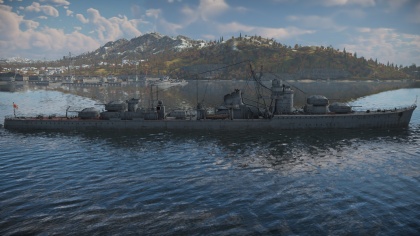IJN Akizuki
Contents
Description
The Akizuki-class, IJN Akizuki, 1944 is a rank III Japanese destroyer
with a battle rating of 4.7 (AB/RB/SB). It was introduced in Update 1.89 "Imperial Navy".
General info
Survivability and armour
Talk about the vehicle's armour. Note the most well-defended and most vulnerable zones, e.g. the ammo magazine. Evaluate the composition of components and assemblies responsible for movement and manoeuvrability. Evaluate the survivability of the primary and secondary armament separately. Don't forget to mention the size of the crew, which plays an important role in fleet mechanics. Save tips for preserving survivability in the "Use in battle" section.
If necessary, use a graphics template to show the most well-protected or most vulnerable points in the armour.
Mobility
Write about the ship’s mobility. Evaluate its power and manoeuvrability, rudder rerouting speed, stopping speed at full tilt, with its maximum forward speed and reverse speed.
Armament
Primary armament
Provide information about the characteristics of the primary armament. Evaluate their efficacy in battle based on their reload speed, ballistics and the capacity of their shells. Add a link to the main article about the weapon: {{main|Weapon name (calibre)}}.
Broadly describe the ammunition available for the primary armament, and provide recommendations on how to use it and which ammunition to choose.
Secondary armament
Some ships are fitted with weapons of various calibres. The secondary armament is defined as the weapon chosen with the control Select secondary weapon. Evaluate the secondary armament and give advice on how to use them. Describe the ammunition available for the secondary armament. Provide recommendations on how to use them and which ammunition to choose. Remember that anti-air armament, even heavy calibre weapons, belong in the next section.
If there is no secondary armament, remove this section.
Torpedo armament
Torpedoes launchers are standard equipment on many ships and boats. Torpedoes are a significant means of defeating an opponent. Evaluate the position of the torpedo launchers, discuss the ammunition available, firing specifics such as dead zones, features of the torpedoes themselves, etc.
If there is no torpedo armament, remove this section.
Special armament
Depth charges, mines, rocket launchers and missiles are also effective in skilled hands and can take an off-guard opponent by surprise. Evaluate the ammunition of this type of armament and rate its performance in combat.
Usage in battles
Describe the technique of using this ship, the characteristics of her use in a team and tips on strategy. Abstain from writing an entire guide – don’t try to provide a single point of view, but give the reader food for thought. Talk about the most dangerous opponents for this vehicle and provide recommendations on fighting them. If necessary, note the specifics of playing with this vehicle in various modes (AB, RB, SB).
Pros and cons
Pros:
- 8х100-mm utility guns
- 35 AA cannons calibre 25 mm
- Heavy torpedoes
Cons:
- No AP shells for the main caliber guns
History
In the late 1920s, the first Japanese aircraft carrier task force was created, consisting of two carriers and two destroyers. The two destroyers proved unsuitable as carrier escorts due to lack of capabilities and range, resulting in the need for more specialized vessels becoming apparent.
Initially, cruiser-class ships were chosen to escort carriers, considered, among other benefits, to have decent anti-air capabilities. However, the proposal was dismissed soon afterwards as a number of projected issues arose. Instead, the decision was made to construct specially designed anti-aircraft destroyers, which would fill the role of carrier escorts.
By July of 1938, a design was awaiting approval by the IJN high command. However, the initial design promised unrealistic performance figures and lacked distinct destroyer features, such as torpedo launchers. As a result, the design was ordered for revision, with a new draft being proposed by September. The final draft was then subsequently approved in April 1939 and the first construction orders for the new Akizuki-class destroyers followed shortly afterwards.
Akizuki, the lead ship of the class, was laid down in the Maizuru Naval Arsenal in July 1940 and saw completion in June 1942. Immediately after her commissioning, Akizuki took part in the Battle of the Eastern Solomons in August, followed up by participating in the Guadalcanal campaign. After her first engagements, Akizuki returned to Japan for repairs in late 1942.
In January 1943, Akizuki was engaged by the American submarine USS Nautilus, receiving severe damage as a result. The subsequent repair efforts lasted until October, before the ship was deemed combat ready again. After participating in the Battle of the Philippine Sea in June 1944, Akizuki departed for what would become her last operation in October 1944. During the Battle of Cape Engaño, Akizuki suffered a catastrophic explosion, which ultimately led to her sinking.
- From Devblog
Media
Excellent additions to the article would be video guides, screenshots from the game, and photos.
See also
Links to the articles on the War Thunder Wiki that you think will be useful for the reader, for example:
- reference to the series of the ship;
- links to approximate analogues of other nations and research trees.
External links
| Japan destroyers | |
|---|---|
| IJN | |
| Momi-class | IJN Momi |
| Mutsuki-class | IJN Mutsuki · IJN Satsuki |
| Fubuki-class | IJN Ayanami |
| Hatsuharu-class | IJN Hatsuharu · IJN Nenohi |
| Shiratsuyu-class | IJN Yuudachi |
| Yugumo-class | IJN Yugumo · IJN Hayanami · IJN Kiyoshimo |
| Shimakaze-class | IJN Shimakaze |
| Akizuki-class | IJN Akizuki · IJN Hatsuzuki |
| JMSDF | |
| Ariake-class* | JDS Yūgure (DD-184) |
| Harukaze-class | JDS Harukaze (DD-101) |
| * Modified Fletcher-class destroyers | |





